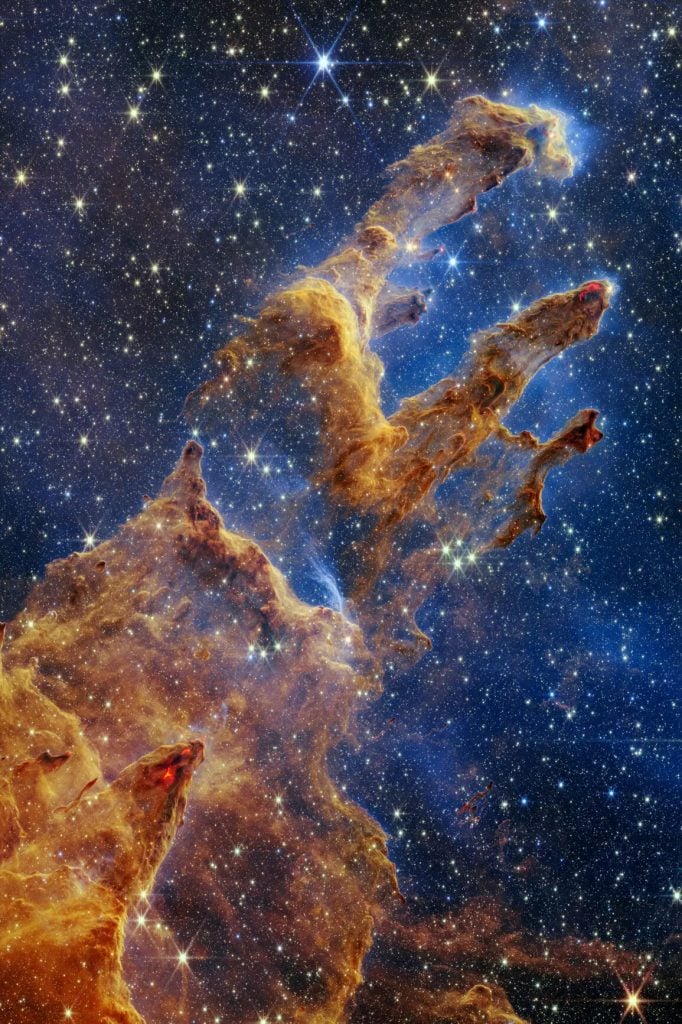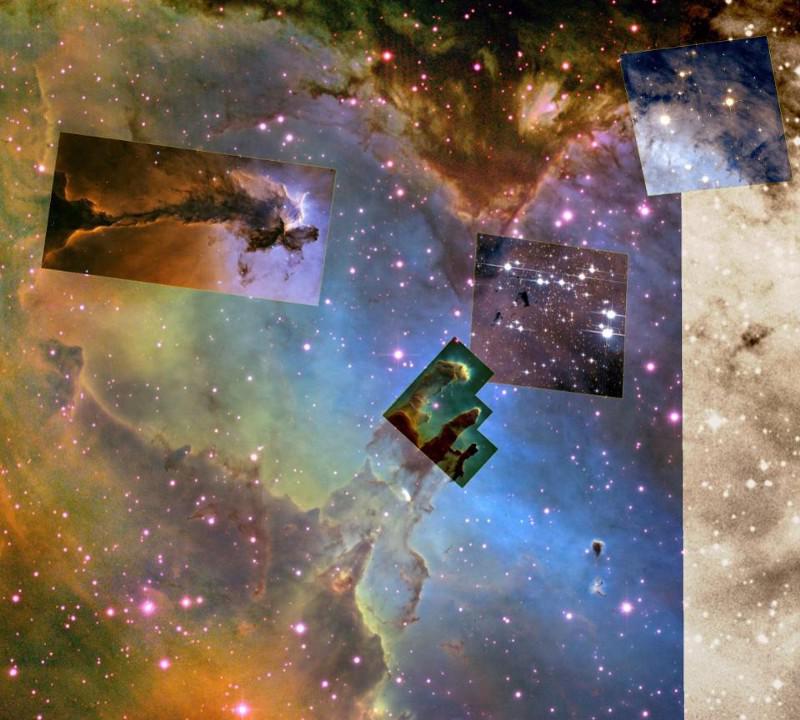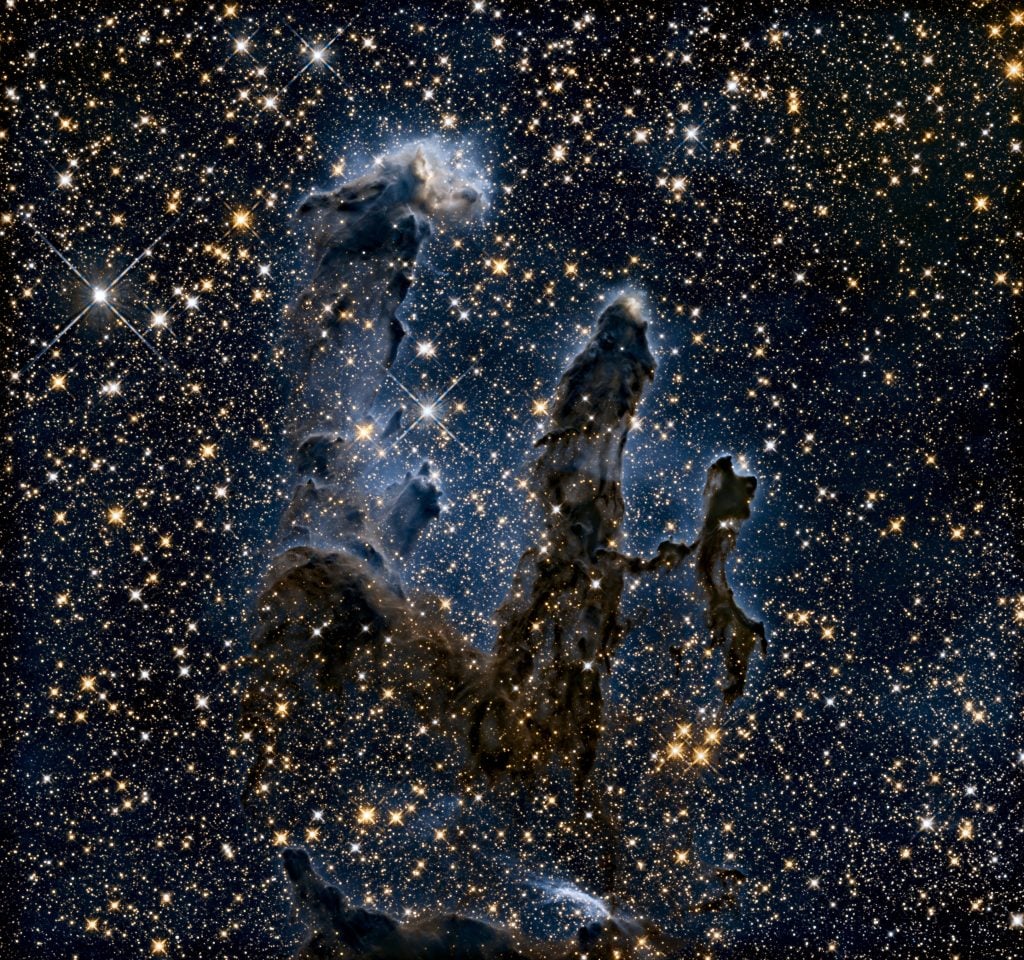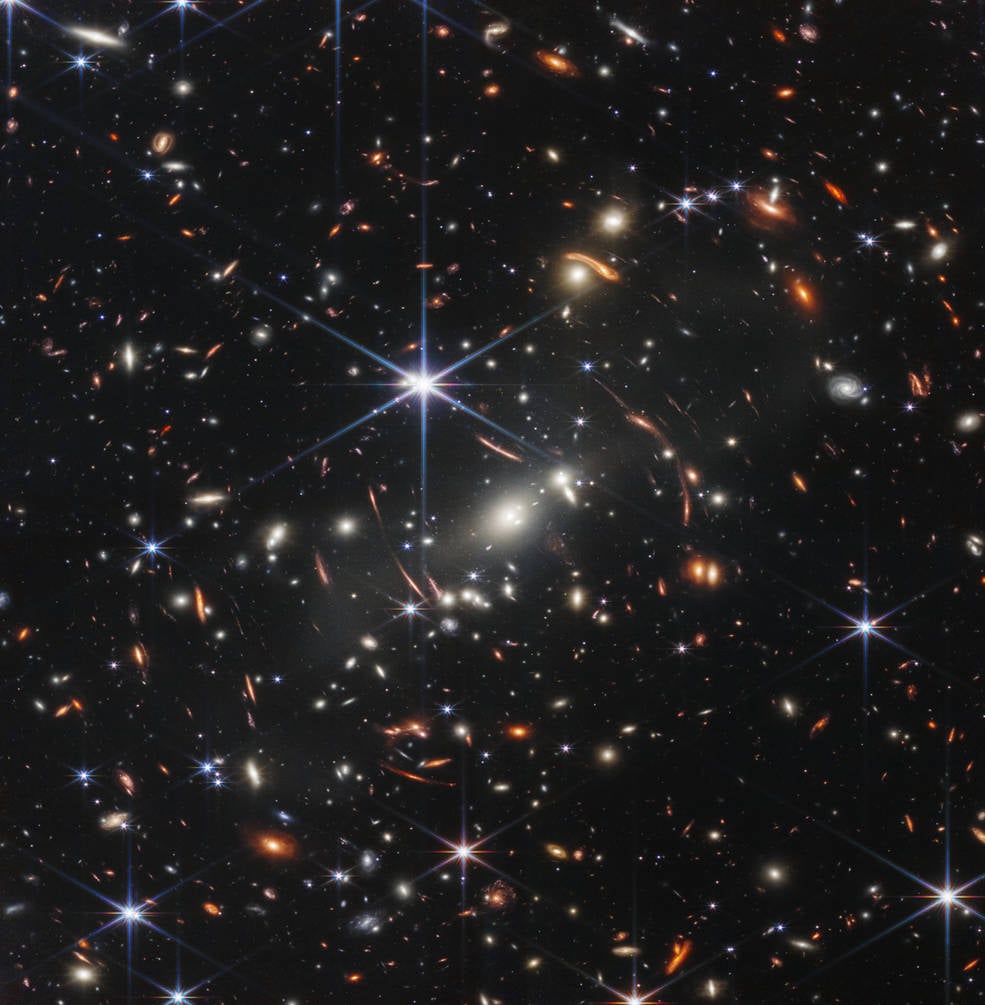Art & Tech
An Astonishing New Image of the ‘Pillars of Creation’ Shows Off the Magic the James Webb Telescope Is Capable Of
The Pillars of Creaton, the subject of one of art history's most beloved space images, gets an infrared makeover.

The Pillars of Creaton, the subject of one of art history's most beloved space images, gets an infrared makeover.

Sarah Cascone

In a stunning shot taken by the new James Webb Space Telescope, NASA has released a new view of the Pillars of Creation, the subject of one of art history’s most famous images of outer space.
The Pillars of Creation are a small portion of the Eagle Nebula or Star Queen Nebula—officially known as Messier 16—an open cluster of stars in the constellation Serpens, some 6,500 light years from earth.
Discovered by Swiss astronomer Jean-Philippe de Cheseaux in 1745, the nebula was made famous in 1995, when Hubble released the first Pillars of Creation image, showing young stars forming amid columns of hydrogen gas and dust known as “elephant trunks”—the shot’s titular pillars.
When NASA first unveiled the original photo—which the New York Times called “high art from deep space”—it acknowledged the eerie nature of the otherworldly landscape, offering several suggestions for what we might be looking at. “Undersea corral? Enchanted castles? Space serpents?”
In actuality, the pillars are incubators for new stars; as they form, stars release a flood of ultraviolet light that burn off the clouds in a process called “photoevaporation.” The cliff-like formations can also be seen inside the wider Eagle Nebula in a composite image by Hubble from 2008 that includes other nearby features, such as the Stellar Spire.
When the Webb team was considering possible observation targets for the new telescope, returning to the Eagle Nebula was an easy choice.
“By popular demand, we had to do the Pillars of Creation,” Webb astronomer Klaus Pontoppidan wrote on Twitter.

A composite of the Hubble Space Telescope’s images of the Eagle Nebula, featuring overlays of a 2005 shot of the Fairy or Stellar Spire, the 1995 view of the Pillars of Creation, and two details of star clusters from 2008. Photo courtesy of NASA, STScI, Hubble Space Telescope, ESA.
“Along the edges of the pillars are wavy lines that look like lava. These are ejections from stars that are still forming,” the European Space Agency wrote in a statement about the new image. “Young stars periodically shoot out jets that can interact within clouds of material, like these thick pillars of gas and dust.”
“The pillars look like arches and spires rising out of a desert landscape, but are filled with semi-transparent gas and dust, and ever changing,” the Webb team wrote along with the photo’s release. “Newly formed stars are the scene-stealers.”
For the 20th anniversary of the Pillars of Creation image in 2015, Hubble released a new snapshot of the star-forming region, enhancing details and eliminating gaps in the original that were left by differences in the magnification capabilities between Hubble’s individual cameras. The result was a massive 33-megabyte file that is nonetheless dwarfed by Webb’s new version, which weighs in at an astonishing 163 megabytes.

NASA’s Hubble Space Telescope made the Eagle Nebula’s Pillars of Creation famous with its first image in 1995, but revisited the scene in 2014 to reveal a sharper, wider view in visible light. That image is seen here compared with a new, near-infrared-light view of the interstellar landscape from NASA’s James Webb Space Telescope. Courtesy of NASA, ESA, CSA, STScI; Joseph DePasquale (STScI), Anton M. Koekemoer (STScI), Alyssa Pagan (STScI).
“While the pillars of gas and dust seem darker and less penetrable in Hubble’s view, they appear more diaphanous in Webb’s,” NASA noted in a statement. “By penetrating the dusty pillars, Webb also allows us to identify stars that have recently—or are about to—burst free.”
The new Pillars of Creation image differs from the well-known Hubble versions not only due to its increased size and resolution, but also because it was imaged in infrared, rather than visual light, which helps pierce the nebula’s thick dust clouds. Hubble does have limited infrared capabilities, and has used them to observe the Pillars of Creation in 2014, creating another interesting point of comparison with the new Webb image.
NASA hopes that by identifying an unprecedented number of stars—including some that are just a few hundred-thousand years old—in the Pillars of Creation, the new Webb image will help give scientists “a clearer understanding of how stars form and burst out of these dusty clouds over millions of years.”

The Eagle Nebula’s Pillars of Creation as captured in infrared light by the Hubble Space Telescope. Courtesy of NASA, ESA/Hubble and the Hubble Heritage Team.
Our understanding of the Pillars of Creation has changed over the years. For a time, astronomers believed a supernova had actually destroyed the stellar landscape some 6,000 years ago. But as of 2018, the latest understanding is that the gaseous clouds are still there, continuing to slowly fade away with time as new stars form.
Webb’s primary mission is to investigate the origins of our universe, using its infrared capabilities to peer into the farthest edges of space, where stars receding into the distance have become red shifted.
The results in that arena have already confounded scientists’ expectations, revealing far-distant galaxies that are surprisingly large, bright, and well-structured.

The James Webb Space Telescope’s first image was this “Deep Field” image of galaxies formed over 13 billion years ago. Courtesy of NASA, ESA, CSA, STScI, Webb ERO.
“The models just don’t predict this,” Garth Illingworth, an astronomer at the University of California at Santa Cruz, told the Washington Post. “How do you do this in the universe at such an early time? How do you form so many stars so quickly?”
But Webb has also been busy observing objects closer to home—including ones in our own solar systems, such as Jupiter and Ganymede, the planet’s largest moon. In a matter of hours, Webb can beam back imagery from opposite ends of the universe, from spiral galaxies, mysterious exoplanets, and even comets speeding toward the sun. (So far, its first images have been nothing short of spellbinding.)
The new, $10 billion telescope was launched last year on Christmas Day, and traveled 1 million miles to L2, a Lagrange point of intersecting gravitational fields where Webb can remain in a constant orbit with only minor adjustments and fuel output.
More Trending Stories:
Click Here to See Our Latest Artnet Auctions, Live Now